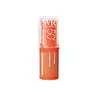What's inside
What's inside
 Key Ingredients
Key Ingredients

 Benefits
Benefits

 Concerns
Concerns

No concerns
 Ingredients Side-by-side
Ingredients Side-by-side

Coco-Caprylate/Caprate
EmollientHelianthus Annuus Seed Wax
Skin ConditioningDiethylamino Hydroxybenzoyl Hexyl Benzoate
UV FilterOctyldodecanol
EmollientBis-Ethylhexyloxyphenol Methoxyphenyl Triazine
Skin ConditioningButyrospermum Parkii Butter
Skin ConditioningDiethylhexyl Butamido Triazone
UV AbsorberCI 77220
Cosmetic ColorantMagnesium Carbonate
AbsorbentOryza Sativa Bran Wax
Skin ConditioningPongamia Glabra Seed Oil
Skin ConditioningDunaliella Salina Extract
Skin ConditioningHaematococcus Pluvialis Extract
AntioxidantHelianthus Annuus Seed Oil
EmollientHydrogenated Olive Oil Unsaponifiables
EmollientHydrogenated Ethylhexyl Olivate
EmollientTocopherol
AntioxidantCoco-Caprylate/Caprate, Helianthus Annuus Seed Wax, Diethylamino Hydroxybenzoyl Hexyl Benzoate, Octyldodecanol, Bis-Ethylhexyloxyphenol Methoxyphenyl Triazine, Butyrospermum Parkii Butter, Diethylhexyl Butamido Triazone, CI 77220, Magnesium Carbonate, Oryza Sativa Bran Wax, Pongamia Glabra Seed Oil, Dunaliella Salina Extract, Haematococcus Pluvialis Extract, Helianthus Annuus Seed Oil, Hydrogenated Olive Oil Unsaponifiables, Hydrogenated Ethylhexyl Olivate, Tocopherol
Propylheptyl Caprylate
EmollientOctyldodecanol
EmollientDicaprylyl Carbonate
EmollientDiethylamino Hydroxybenzoyl Hexyl Benzoate
UV FilterTriethyl Citrate
MaskingTributyl Citrate
SolventEthylhexyl Triazone
UV AbsorberBis-Ethylhexyloxyphenol Methoxyphenyl Triazine
Skin ConditioningDibutyl Lauroyl Glutamide
Skin ConditioningDiethylhexyl Butamido Triazone
UV AbsorberDibutyl Ethylhexanoyl Glutamide
Skin ConditioningLepidium Sativum Sprout Extract
Skin ConditioningHelianthus Annuus Seed Oil
EmollientTocopherol
AntioxidantCaprylic/Capric Triglyceride
MaskingPropylheptyl Caprylate, Octyldodecanol, Dicaprylyl Carbonate, Diethylamino Hydroxybenzoyl Hexyl Benzoate, Triethyl Citrate, Tributyl Citrate, Ethylhexyl Triazone, Bis-Ethylhexyloxyphenol Methoxyphenyl Triazine, Dibutyl Lauroyl Glutamide, Diethylhexyl Butamido Triazone, Dibutyl Ethylhexanoyl Glutamide, Lepidium Sativum Sprout Extract, Helianthus Annuus Seed Oil, Tocopherol, Caprylic/Capric Triglyceride
 Reviews
Reviews

Ingredients Explained
These ingredients are found in both products.
Ingredients higher up in an ingredient list are typically present in a larger amount.
You might know this ingredient as Tinosorb S or Bemotrizinol. It is a UV filter that covers both UVA and UVB rays.
This ingredient has two peak UV absorption peaks ( 310 and 340 nm) and is able to absorb both UV-A and UV-B rays. This ingredient works by preventing UV rays from reaching and damaging your skin.
On top of that - it is highly photostable and helps prevent the photodegration of other sunscreen ingredients such as avobenzone.
Tinosorb S is allowed in the EU, Australia, and Asia. It is close to being approved by the FDA and we'll hopefully get this ingredient in the U.S. by late 2025.
Fun fact: Tinosorb S is the most effective UV absorber at maximum concentration (measured by SPF) permitted in the EU.
This ingredient is oil-soluble, so your oil-cleansers will take this right off at night.
Learn more about Bis-Ethylhexyloxyphenol Methoxyphenyl TriazineDiethylamino Hydroxybenzoyl Hexyl Benzoate (DHHB) is a chemical UV-A absorber. It is formulated for high UVA protection (320-400 nm).
DHHB is well-liked for:
DHHB has been approved by the EU, Japan, Taiwan, and South America for use up to 10%. Unfortunately, it has not been approved for use in the US or Canada due to slow regulatory processes.
This ingredient is soluble in oils, fats, and lipids.
Learn more about Diethylamino Hydroxybenzoyl Hexyl BenzoateDiethylhexyl Butamido Triazone is a photostable UV absorber. It protects in both the UVB and UVA II range.
The great thing about this ingredient is that it is ultra-photostable at low concentrations.
It is also pretty water-resistant and is highly oil-soluble (so your oil cleanser will get it off right away).
This ingredient is currently available in Europe and Japan, but not in the US.
Learn more about Diethylhexyl Butamido TriazoneHelianthus Annuus Seed Oil is the oil derived from the seeds of a Sunflower. Sunflower seed oil is non-fragrant. It is an emollient, meaning it helps to soften the skin.
Sunflower seed oil contains many fatty acids. The fatty acids found in sunflower seeds include (from highest amount to least): linoleic acid, myristic acid, palmitic acid, stearic acid, arachidic acid, oleic acid, and linolenic acid.
These fatty acids help the skin create ceramides. Ceramides play a role in repairing the skin barrier.
Helianthus Annuus Seed Oil helps moisturize the skin. This in turn helps the skin look more rejuvenated and smoother.
Sunflowers are rich in vitamin E.
Historians believe Indigenous cultures of North America domesticated sunflowers before corn. Thus they relied on sunflower oil for a variety of uses. One such use is moisturizing skin and hair.
Sunflower seed oil may not be fungal acne safe. We recommend speaking with a professional if you have any concerns.
Learn more about Helianthus Annuus Seed OilOctyldodecanol is a fatty alcohol. It is primarily used to enhance the texture of products.
As an emulsifier, Octyldodecanol helps prevent the oils and waters from separating. It also prevents ingredients from creating foam when shaken.
Octyldodecanol is created by reducing fatty acid to an alcohol.
Due to its high molecular weight, it does not get absorbed into the skin.
Learn more about OctyldodecanolTocopherol (also known as Vitamin E) is a common antioxidant used to help protect the skin from free-radicals and strengthen the skin barrier. It's also fat soluble - this means our skin is great at absorbing it.
Vitamin E also helps keep your natural skin lipids healthy. Your lipid skin barrier naturally consists of lipids, ceramides, and fatty acids. Vitamin E offers extra protection for your skin’s lipid barrier, keeping your skin healthy and nourished.
Another benefit is a bit of UV protection. Vitamin E helps reduce the damage caused by UVB rays. (It should not replace your sunscreen). Combining it with Vitamin C can decrease sunburned cells and hyperpigmentation after UV exposure.
You might have noticed Vitamin E + C often paired together. This is because it is great at stabilizing Vitamin C. Using the two together helps increase the effectiveness of both ingredients.
There are often claims that Vitamin E can reduce/prevent scarring, but these claims haven't been confirmed by scientific research.
Learn more about Tocopherol